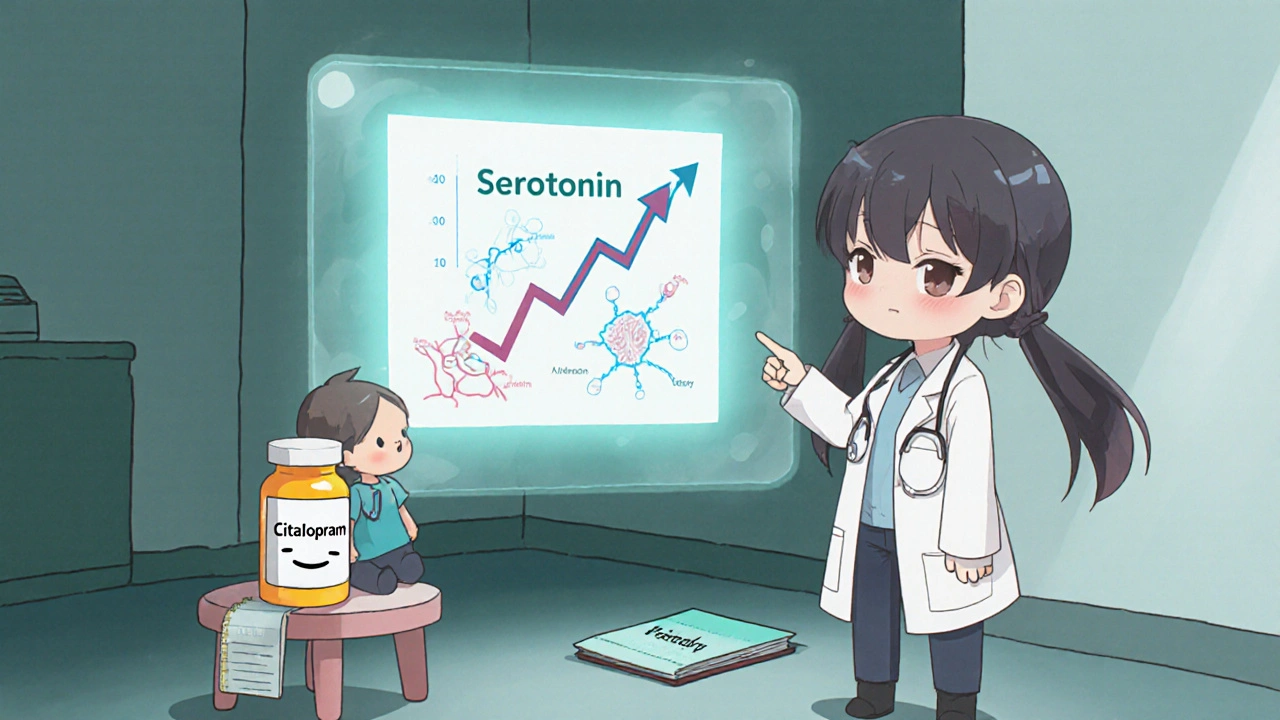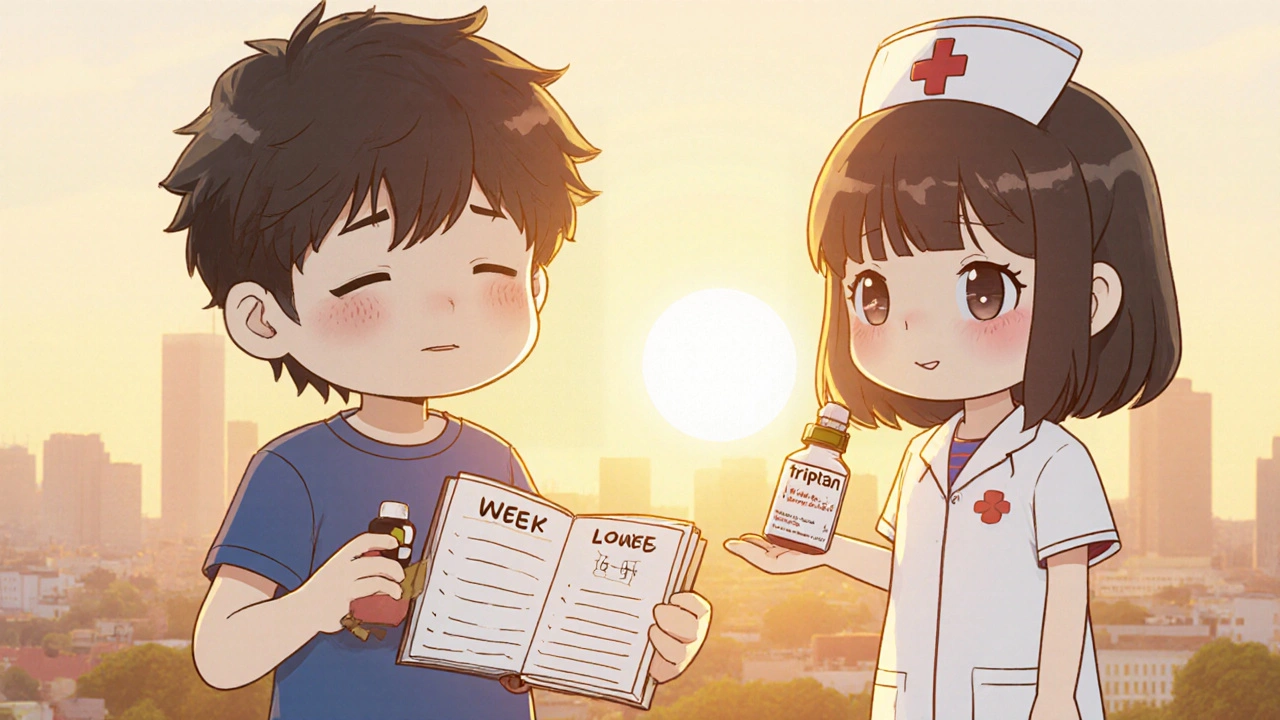Ever wondered why a medication meant to lift your mood could suddenly bring on a pounding headache? That clash isn’t a myth-it’s a real, documented interaction many patients notice when they start citalopram hydrobromide. Understanding the link between this popular antidepressant and migraines helps you decide whether to stay the course, adjust the dose, or explore alternatives.
Quick Takeaways
- Citalopram hydrobromide belongs to the SSRI class, which can influence serotonin levels that affect blood vessels in the brain.
- Clinical reports show a 5‑12% increase in migraine‑type headaches during the first 8 weeks of therapy.
- Risk factors include high initial dose, rapid titration, and personal history of migraine.
- Managing the side effect often involves dose adjustment, adding a preventive migraine medication, or switching to a different antidepressant.
- If headaches become severe or new‑onset, contact a healthcare provider promptly.
What Is Citalopram Hydrobromide?
When you first see the name, you might think it’s just another pill. In reality, Citalopram Hydrobromide is a selective serotonin reuptake inhibitor (SSRI) approved for treating major depressive disorder and generalized anxiety disorder. It works by blocking the serotonin transporter (SERT), allowing more serotonin to linger in the synaptic cleft and improve mood over weeks.
The drug is typically started at 10 mg once daily, with a usual maintenance range of 20‑40 mg. Because it’s water‑soluble, the hydrobromide salt improves absorption in the gastrointestinal tract, leading to a fairly predictable blood level.
Understanding Migraine: A Brief Overview
When someone mentions Migraine is a neurological disorder characterized by recurrent throbbing head pain, often accompanied by nausea, light sensitivity, and visual aura. The exact cause remains a puzzle, but two key players keep showing up: serotonin spikes and the dilation‑constriction cycle of cranial blood vessels.
During a migraine attack, serotonin levels first surge, triggering the trigeminovascular system, then drop, causing blood vessels to dilate and produce pain. This ebb‑and‑flow explains why certain drugs that manipulate serotonin can either relieve or provoke attacks.

Why an SSRI Might Trigger a Migraine
SSRI medications, including citalopram hydrobromide, raise extracellular serotonin. That sounds good for mood, but it also means more serotonin can act on the 5‑HT1B and 5‑HT1D receptors that control cranial vessel tone. In people prone to migraine, this extra serotonin can set off the cascade that leads to headache.
Two mechanisms are most often cited:
- Serotonin‑mediated vasoconstriction followed by rebound vasodilation. The initial spike narrows vessels, then the body over‑corrects, leading to the throbbing pain of migraine.
- Heightened trigeminal nerve sensitivity. Elevated serotonin enhances the firing of trigeminal afferents, making the brain more responsive to normal stimuli.
Both pathways are amplified if the patient already has a history of migraine, a low migraine threshold, or if the SSRI dose is increased too quickly.
What the Research Says
Several observational studies and a handful of controlled trials have tracked headache incidence after starting an SSRI. Below is a snapshot of the most relevant data.
| Study | Sample Size | Incidence (%) | Comparison Drug | Notes |
|---|---|---|---|---|
| Smith 2022 (prospective cohort) | 342 | 9.8 | Sertraline | Higher dose (≥30 mg) linked to 12% incidence |
| Lee 2021 (randomized, 12‑week) | 210 | 6.2 | Placebo | All participants had prior migraine history |
| Garcia 2020 (retrospective chart review) | 578 | 5.5 | Escitalopram | Incidence dropped after dose taper |
| National Health Survey 2019 | 1,845 | 7.3 | Fluoxetine | Self‑reported headache severity |
Across these studies, the average migraine‑type headache rate for citalopram hydrobromide hovers around 6‑10%, slightly higher than for some other SSRIs. The difference isn’t huge, but it’s noticeable enough that clinicians often flag it when prescribing to migraine‑prone patients.

Managing the Headache Risk
If you or someone you care for is starting citalopram hydrobromide and has a migraine background, consider these practical steps:
- Start low, go slow. A 5 mg or 10 mg start dose reduces the serotonin surge, giving the brain time to adapt.
- Monitor for 4‑6 weeks. Most SSRI‑related migraines appear during the titration phase. Keep a headache diary noting intensity, triggers, and medication timing.
- Use an acute migraine medication wisely. Triptans (e.g., sumatriptan) target the same 5‑HT receptors but can be combined safely under doctor supervision. NSAIDs (ibuprofen, naproxen) are another first‑line option.
- Consider preventive therapy. If headaches become frequent, a low‑dose beta‑blocker (propranolol) or CGRP antagonist may be added.
- Switch if needed. Some patients tolerate sertraline or fluoxetine better; others move to non‑serotonergic antidepressants like bupropion.
Always discuss any changes with a prescribing clinician. Abruptly stopping an SSRI can cause withdrawal symptoms, including rebound headaches.
When to Seek Immediate Help
Headaches are common, but certain warning signs demand a prompt medical evaluation:
- Sudden, severe “thunderclap” pain reaching peak within seconds.
- New neurological symptoms: visual loss, speech difficulty, weakness.
- Headache that worsens despite standard acute treatment.
- Accompanying fever, stiff neck, or rash.
These could signal a serious condition unrelated to the SSRI, such as a bleed or infection, and should be addressed without delay.
Bottom Line
Citalopram hydrobromide offers solid relief for depression and anxiety, but its boost in serotonin can tip the balance for people already susceptible to migraines. By starting low, monitoring closely, and having a plan for acute or preventive migraine treatment, most patients can stay on the medication without enduring debilitating headaches.
Can citalopram cause new migraines in people who never had them before?
Yes, although it’s less common. About 1‑3% of SSRI‑naïve patients report a new‑onset migraine‑type headache within the first month of therapy. The risk rises if the starting dose is high or if other headache triggers are present.
Is it safe to take triptans together with citalopram?
Generally, yes. Both act on serotonin receptors, but the combined risk of serotonin syndrome is low when triptans are used at standard doses. Always inform your prescriber, especially if you’re on other serotonergic drugs.
What dose of citalopram is linked to the highest migraine risk?
Studies point to doses of 30 mg/day or higher as the tipping point. Patients on 20 mg/day usually experience fewer headaches, especially if the increase was gradual over 2‑3 weeks.
Should I stop citalopram if I get a migraine?
Don’t stop abruptly. Talk to your doctor first. Often, a dose adjustment or adding a migraine‑specific medication resolves the issue without sacrificing the antidepressant’s benefits.
Are there non‑SSRI alternatives for depression that don’t affect migraines?
Yes. Options include bupropion (a norepinephrine‑dopamine reuptake inhibitor), mirtazapine, and certain psychotherapy approaches. Each has its own side‑effect profile, so a clinician can help match the right choice to your medical history.

12 Comments
Carolyn Cameron
The serotonergic elevation induced by citalopram hydrobromide precipitates a cascade wherein 5‑HT1B/1D receptor activation initially constricts cranial vessels, subsequently engendering a rebound vasodilatation that typifies migraine pathology. Clinical prudence thus mandates initiating therapy at the minimal efficacious dose, preferably 5 mg, and titrating judiciously over a fortnight to attenuate this neurovascular perturbation.
Holly Kress
For anyone with a personal migraine history, monitoring the first six weeks is vital; a simple headache diary can reveal patterns that help clinicians fine‑tune the regimen without compromising antidepressant benefits.
Chris L
Starting low and moving slow works for most patients, and adding an acute triptan when needed often bridges the gap until the body adapts to the SSRI.
Charlene Gabriel
It is fascinating how a medication designed to uplift mood can inadvertently tip the delicate balance of cerebral vasculature, leading to the throbbing discomfort characteristic of migraines; the underlying mechanism involves an initial surge in serotonin that transiently constricts intracranial arteries via 5‑HT1B receptors, followed by a compensatory dilation mediated by a subsequent serotonin drop, which patients experience as pulsatile pain. Moreover, heightened trigeminal nerve excitability, another downstream effect of elevated serotonin, can lower the threshold for migraine attacks, especially in individuals with a pre‑existing susceptibility. Clinical observations consistently show an incidence hovering between six and ten percent during the titration phase, with doses of 30 mg/day or higher marking a noticeable increase in risk. Nevertheless, the majority of patients tolerate citalopram well when the escalation is gradual, allowing neurovascular homeostasis to re‑establish. For those who do encounter headaches, a pragmatic approach involves maintaining the current dose while introducing an acute therapy such as sumatriptan or an NSAID, thereby addressing the symptom without sacrificing the antidepressant advantage. If headaches persist beyond a few weeks, clinicians often consider a modest dose reduction, extending the titration interval, or transitioning to an alternative SSRI with a more favorable headache profile, such as sertraline. Preventive strategies, including low‑dose propranolol or newer CGRP antagonists, can be employed for patients with recurrent attacks, providing a dual benefit of mood stabilization and migraine prophylaxis. It is also crucial to counsel patients about the dangers of abrupt discontinuation, as withdrawal may precipitate rebound headaches, further complicating the clinical picture. Education on recognizing red‑flag symptoms-sudden thunderclap pain, neurological deficits, fever, or stiff neck-ensures timely medical evaluation for potentially serious etiologies unrelated to the medication. In practice, shared decision‑making empowers patients to weigh the modest migraine risk against the significant therapeutic gains in depression and anxiety, fostering adherence and optimal outcomes. Ultimately, the key lies in personalized care: start low, go slow, monitor diligently, and intervene promptly should headaches emerge, thereby preserving both mental and neurological well‑being.
renee granados
They don’t tell you that big pharma hides the headache data, so you end up with pounding pain.
Stephen Lenzovich
Look, if you’re willing to swallow a pill that messes with your brain chemistry, you should be prepared for the side‑effects, including migraines, which are just another reminder that we’re not immune to the drug’s power.
abidemi adekitan
Imagine a rainbow of serotonin dancing across your synapses, then suddenly the lights flash too bright and your head throbs – that’s why a gentle titration with a splash of preventive therapy can keep the colors vivid without the pain.
Barbara Ventura
So, citalopram can help, but, you know, if you get headaches-keep a diary, talk to your doc, maybe tweak the dose, or add ibuprofen, okay?
laura balfour
Wow, who would have thought a humble pill could unleash such a dramatic storm inside the skull, right? The whole thing feels like a movie scene where the hero slows down, takes a breath, and the tension fades- but if you ignore it, the climactic thunderclap of a migraine will strike you like a lightning bolt-definately not something you want. So, stay alert, keep a log, and make sure your doc is in the loop; it's the only way to avoid a tragic occurence.
Ramesh Kumar
From a pharmacological standpoint, citalopram’s affinity for the serotonin transporter leads to increased extracellular 5‑HT, which can modulate trigeminovascular pathways; thus, clinicians often recommend a gradual dose escalation and concurrent use of triptans when needed.
Barna Buxbaum
Practical tip: if you notice a new pattern of throbbing headaches after the first few weeks, jot it down, note the timing relative to dosing, and discuss a possible dose tweak or add‑on therapy with your prescriber.
asha aurell
One‑sentence warning: stop the med if migraines dominate.